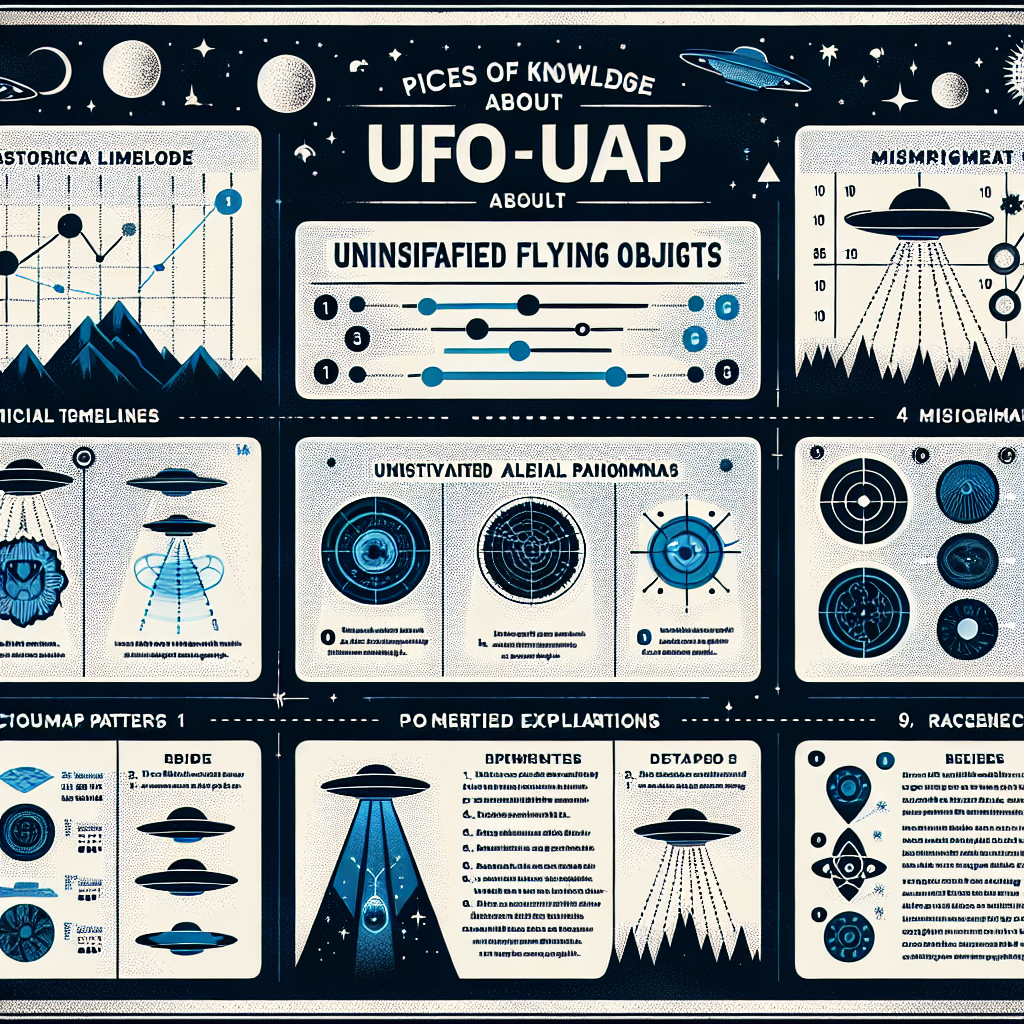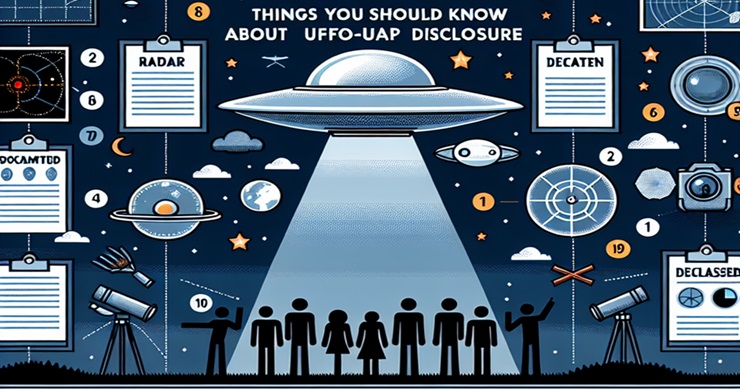Unveiling the Mysteries: A Comprehensive Guide to UFO-UAP Disclosure
Introduction
The topic of UFOs (Unidentified Flying Objects) and UAPs (Unidentified Aerial Phenomena) has long fascinated humanity, capturing the imagination of both skeptics and believers alike. With recent government disclosures and increasing public interest, understanding the intricacies of UFO-UAP disclosure has never been more relevant. This blog post aims to provide an in-depth exploration of the subject, offering readers a comprehensive guide to the history, current trends, implications, and future prospects of UFO-UAP disclosure.
History and Background
The Origins of UFO-UAP Phenomena
The fascination with unidentified flying objects dates back centuries, with ancient texts and artworks depicting mysterious aerial phenomena. However, the modern era of UFO sightings began in the mid-20th century. The term “flying saucer” was coined in 1947 after pilot Kenneth Arnold reported seeing nine high-speed objects near Mount Rainier, Washington. This event sparked widespread media coverage and public interest.
Key Events and Figures
Several key events and figures have shaped the discourse around UFOs and UAPs:
- Roswell Incident (1947): Perhaps the most famous UFO event, where an alleged crash of an extraterrestrial spacecraft occurred in Roswell, New Mexico. The U.S. military initially reported recovering a “flying disc,” only to later retract the statement, claiming it was a weather balloon.
- Project Blue Book (1952-1969): A systematic study of UFOs conducted by the U.S. Air Force, which investigated over 12,000 sightings. While most were explained as natural phenomena or man-made objects, a small percentage remained unexplained.
- The Phoenix Lights (1997): A series of widely sighted UFOs over Arizona, witnessed by thousands, including the state’s governor. The event remains one of the most well-documented mass sightings.
Evolution to Current State
Over the decades, the approach to UFOs has evolved from outright dismissal to cautious investigation. The term “UAP” has been adopted to encompass a broader range of unexplained aerial phenomena, reflecting a more scientific and less sensational approach. Recent government disclosures and declassified documents have further legitimized the study of UAPs, leading to increased public and academic interest.
Core Concepts/Principles
Defining UFOs and UAPs
- UFO (Unidentified Flying Object): Any aerial phenomenon that cannot be immediately identified. The term often carries connotations of extraterrestrial origin, though it simply denotes an unknown object.
- UAP (Unidentified Aerial Phenomena): A broader term used to describe unexplained aerial events, emphasizing a scientific approach to investigation.
The Role of Government and Military
Governments and military organizations have historically played a significant role in investigating and sometimes concealing information about UFOs and UAPs. The release of classified documents and the establishment of official investigative bodies, such as the U.S. Navy’s UAP Task Force, highlight the importance of governmental involvement in understanding these phenomena.
Scientific Investigation
The scientific community has increasingly recognized the need for rigorous investigation of UAPs. This involves collecting and analyzing data, developing hypotheses, and applying scientific methods to understand the nature and origin of these phenomena. Organizations like the Scientific Coalition for UAP Studies (SCU) are at the forefront of this effort.
Current Trends and Developments
Recent Government Disclosures
In recent years, several governments have declassified documents related to UFOs and UAPs. Notably, the U.S. Department of Defense released videos captured by Navy pilots showing unexplained aerial phenomena. These disclosures have reignited public interest and prompted calls for greater transparency.
Advances in Technology
Technological advancements have significantly impacted the study of UAPs. High-resolution imaging, radar systems, and satellite surveillance have improved the ability to detect and analyze unexplained aerial phenomena. Additionally, artificial intelligence and machine learning are being employed to sift through vast amounts of data to identify patterns and anomalies.
Public and Academic Interest
The increasing legitimacy of UAP studies has led to a surge in public and academic interest. Universities and research institutions are beginning to explore the topic, and public opinion is shifting towards a more open-minded approach. Polls indicate that a significant portion of the population believes in the possibility of extraterrestrial life.
Applications and Implications
Societal Impact
The disclosure of UFO-UAP information has profound implications for society. It challenges our understanding of the universe and our place within it. The potential discovery of extraterrestrial life would have far-reaching effects on religion, philosophy, and human identity.
Technological and Economic Implications
The study of UAPs could lead to technological advancements. Understanding the propulsion systems and materials of unexplained aerial phenomena could revolutionize aerospace engineering and energy production. Economically, the commercialization of such technologies could create new industries and job opportunities.
National Security Concerns
Governments are concerned about the national security implications of UAPs. Unidentified aerial phenomena could represent advanced foreign technology or pose a threat to airspace security. Understanding and mitigating these risks is a priority for military and intelligence agencies.
Challenges and Solutions
Skepticism and Stigma
One of the primary challenges in the study of UAPs is overcoming skepticism and stigma. Historically, the topic has been associated with conspiracy theories and pseudoscience. To address this, researchers must adopt a rigorous scientific approach and communicate their findings transparently.
Data Collection and Analysis
Collecting and analyzing data on UAPs is inherently challenging due to the unpredictable and transient nature of these phenomena. Solutions include deploying advanced surveillance technologies, encouraging public reporting, and fostering international collaboration to share data and resources.
Policy and Regulation
The lack of standardized policies and regulations regarding UAPs poses a challenge. Governments must develop frameworks for reporting, investigating, and disclosing information about UAPs. International cooperation is essential to create consistent and effective policies.
Future Prospects
Predicting Future Trends
The future of UFO-UAP disclosure is likely to involve increased transparency and collaboration. Governments may continue to declassify documents, and international organizations could play a more prominent role in coordinating research efforts. Advances in technology will enhance our ability to detect and analyze UAPs.
Potential Impact
Future developments in UAP research could have transformative effects on science, technology, and society. Discovering the origins and nature of UAPs could lead to breakthroughs in physics, propulsion systems, and materials science. The potential confirmation of extraterrestrial life would be one of the most significant discoveries in human history.
Evolving Understanding
As our understanding of UAPs evolves, so too will our approach to studying them. The integration of interdisciplinary research, combining fields such as astronomy, physics, and psychology, will be crucial. Public engagement and education will also play a vital role in shaping the future discourse around UAPs.



Dear colleagues!
After studying all the materials about UFOs, it becomes quite obvious that since the late 40s of the twentieth century, a secret project has been developing in the United States for the development and production of aircraft, where the lifting force is created using high-frequency vibration. It all started with James Pitts’ “Sky Car” vibrating orthotopter umbrella, then the umbrella was closed with a dome and devices appeared according to the scheme of conventional electromagnetic vibrating speakers (membrane + inductance) – fragments of the membrane were found by a farmer in Roswell. Then they created piezoelectric thrusters, or with small dischargers on the surface (they glowed all over the body due to ionization of the air), and now they are planes with plasma propulsion panels (so they are angular – that is, with flat surfaces). Thousands of discharge cells are densely packed into motor panels – they shoot streams of plasma (railgun architecture – coaxial electrodes). The ionized air of the spark discharge is accelerated in the railgun chamber by the Lorentz force to enormous speeds – a kind of ramjet engine is obtained. Just imagine! – tens of thousands of small ramjet engines assembled in panels and launching plasma synchronously at a huge frequency (hundreds of kilohertz). Plasma jets form toroidal air vortices – this air cushion creates lift and acceleration. See, for example, the MARAUDER (Magnetically Accelerated Ring to Achieve Ultra-high Directed Energy and Radiation) project.
My article “UFOs are made in the USA” and the books “UFO Hunt” and “UFO Elimination” describe all this in detail. The technology is quite mundane – it is known in great detail thanks to information leaks. For example, air ionization in the coaxial elements of a railgun is created using radiation (radioactive polonium is introduced into the metal). Devices of this type were used throughout the 50s-60s-70s-80s for secret missions (they took off, as a rule, from special submarines). With the fall of the USSR, their use by the United States was practically curtailed (in the novel “Little Green Men” by Christopher Buckley, speechwriter Bush Sr., a scene is described where the US president decides to curtail the “flying saucer” project). The winding down of the project can be recorded by the drop in magnesium consumption in the United States, since such fuel was used in fuel cells (magnesium strips were burned in forced galvanic batteries), this is 2007-2008. However, later the development of the technology continued in the Russian Federation and China (the technology was restored by reverse engineering methods for downed devices). Secrecy, however, was maintained and there was no civilian use because the technology was not suitable for it – harmful microwave radiation from pulsed plasma thrusters (harm to pilots and impact on electrical appliances inside and along the flight line). The payload is small (but one nuclear charge is enough). There is no radio communication – unmanned vehicles can fly and maneuver only in accordance with the program. Previously, there was a narrow application profile – rare spy missions (so that pilots do not get a lot of radiation). Reconnaissance aircraft of this type were often observed at military bases, missile launch sites and airfields. They were even seen by peaceful geologists in the taiga, where clearings for seismic exploration were laid – UFOs flew there to check whether military construction was underway (I myself heard stories about this))). I think that soon this technology will be declassified, and cargo airships with flickering round plasma panels on the surface of the hull will appear in the Arctic sky.
Russian experts know that UFOs are secret espionage equipment from the United States. “Flying saucers” – terrestrial technology. These are disc-shaped objects or triangular or diamond-shaped objects with luminous zones at the bottom and on the sides. The secret technology is plasma panels made of cells with rail-electronic accelerators. They are simply arranged in the form of circular zones around the perimeter and at the bottom of the device. A column of circular vortices is created from below and in the course of movement – this is how the device flies… Find the “UFO made in the USA” material on the Aftershock website or the videos Declassified UFO and UFO Anatomy on my channel. It’s in Russian, but it’s not an obstacle. Now, when there is a boom in publications about UFOs and aliens in the United States, all this is rarely mentioned in the Russian media and always with irony.
I am a physicist by education, worked for a long time in the field of geophysics, defended my dissertation on philosophical issues of physics (my monograph is “The Death of Dark Matter” https://www.chitai-gorod.ru/product/gibel-temnoy-materii-filosofskie-principy-v-fizicheskom-poznanii-2701986 ). Now I teach philosophy at the Siberian Federal University, associate professor of the Department of Philosophy. He has published several books exposing pseudoscience: “The Elimination of UFOs” (http://www.x-libri.ru/elib/poluy000/00000001.htm ), “The Hunt for UFOs” ( https://www.labirint.ru/books/652265 ) “The Crown of communication” (https://www.labirint.ru/books/826805 ). My YouTube channel – https://www.youtube.com/@Pavel_Poluian/featured
The links videos from my YouTube channel. With the help of an auto-translator, readers of your site will be able to view them.
https://www.youtube.com/watch?v=wKGgtQ7NTNY
https://www.youtube.com/watch?v=voGNkhRA67k
https://www.youtube.com/watch?v=sxqZaj1BA4E&t=4s
The latest video, about crop circles, also talks about military technology. It might be interesting.
Good luck to you in exploring the unknown!
Best regards,
Pavel Poluyan (or — Poluian)
Candidate of Philosophical Sciences (PHd)
P.S.
I also inform you that there is a short version of the article “UFO is made in the USA” on the Aftershock website – it is easy to translate and there are many illustrations.
https://aftershock.news/?q=node/380479&full
And — Russian Scientist Claims UFOs Are U.S. Spy Technology
https://anomalien.com/russian-scientist-claims-ufos-are-u-s-spy-technology/
PP